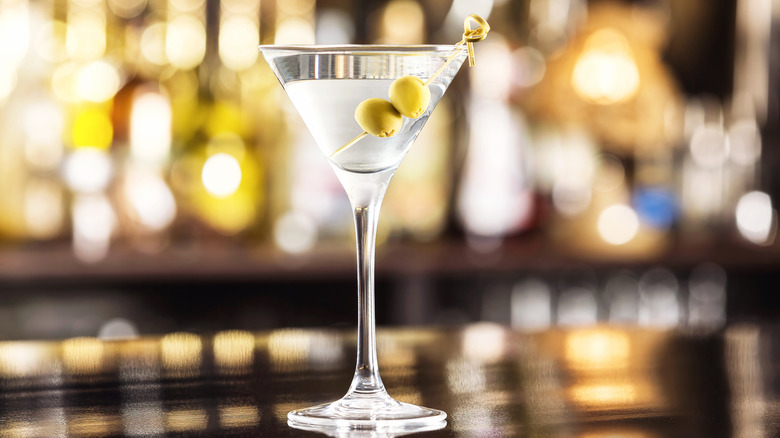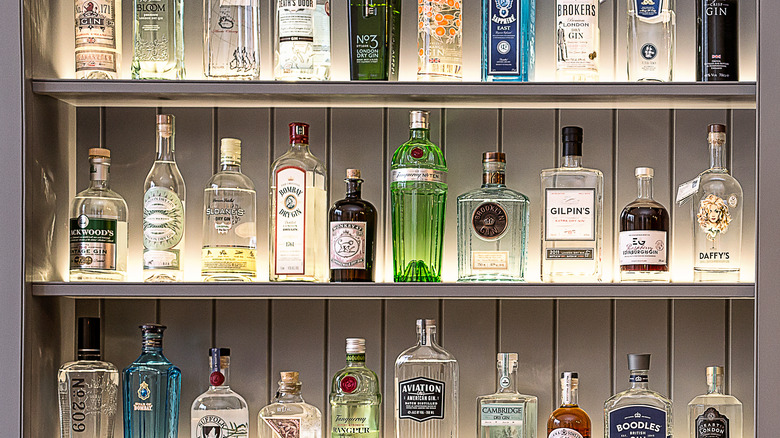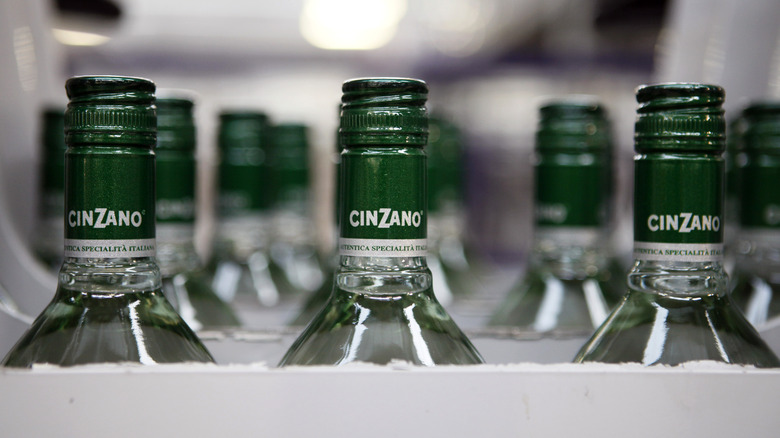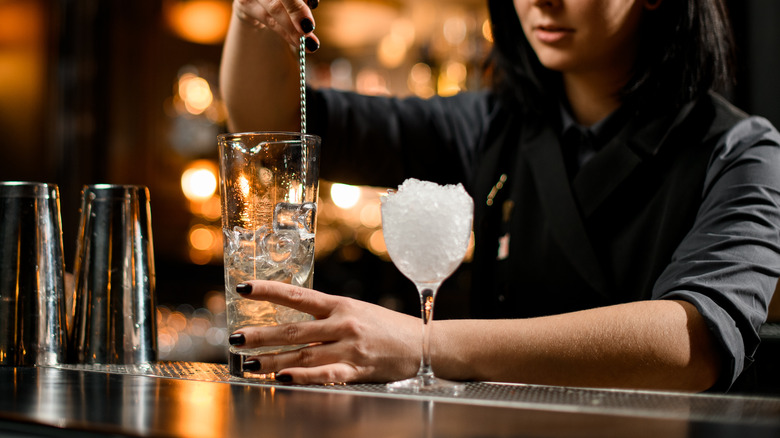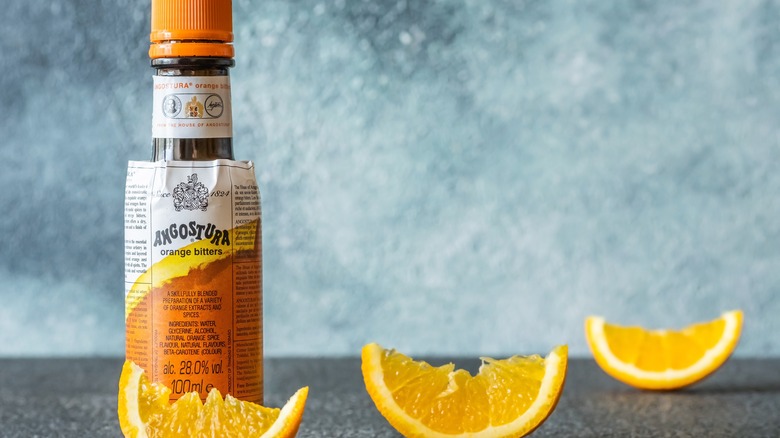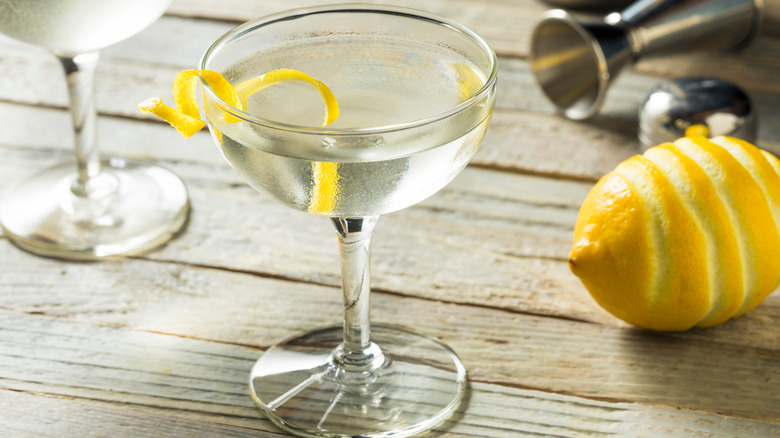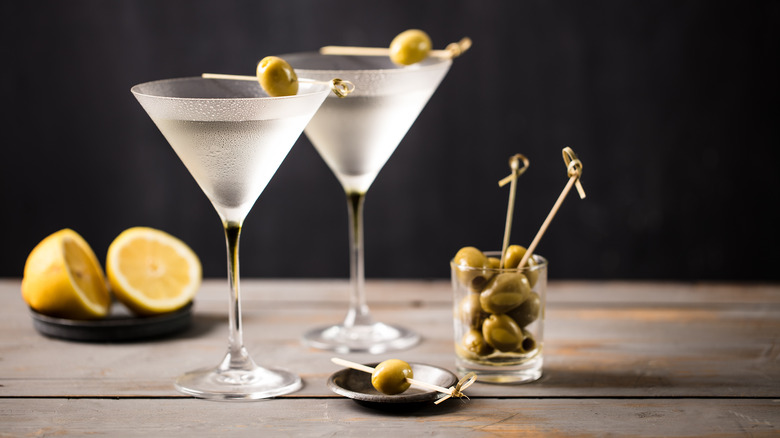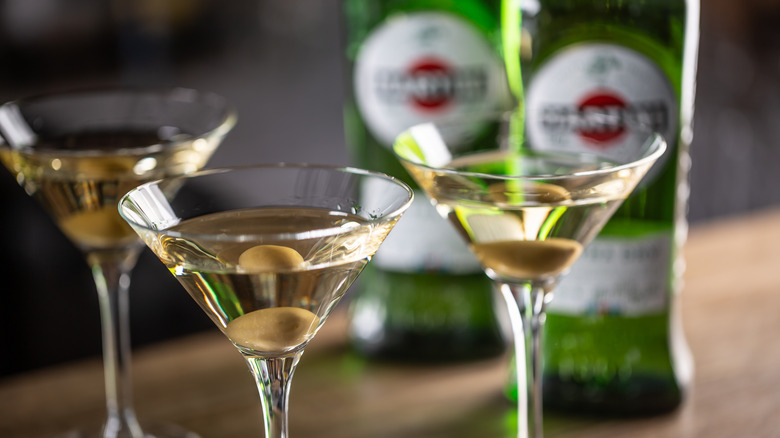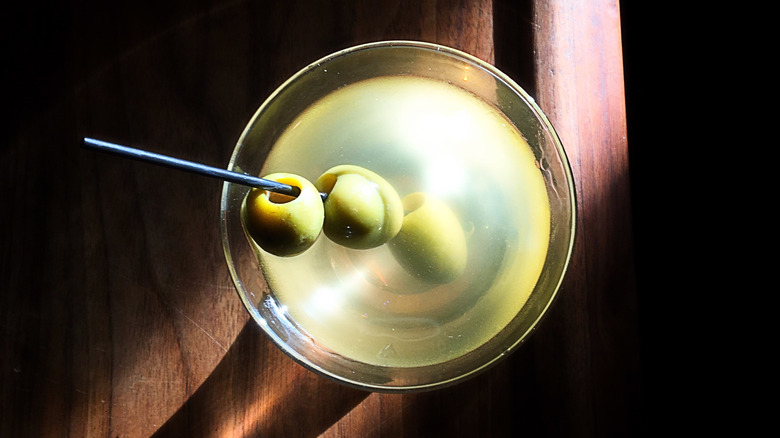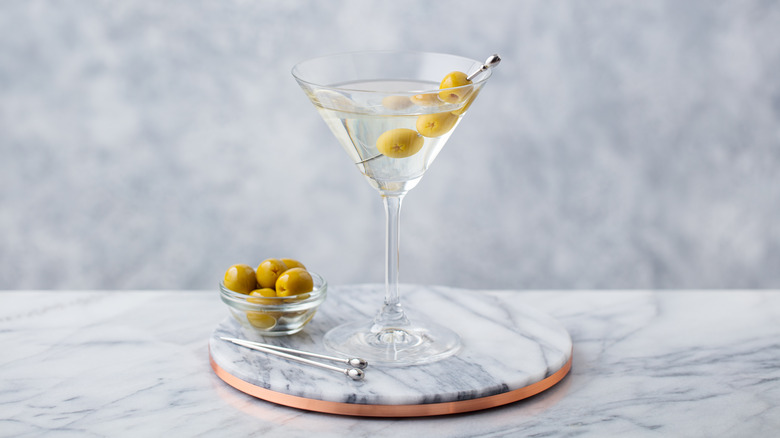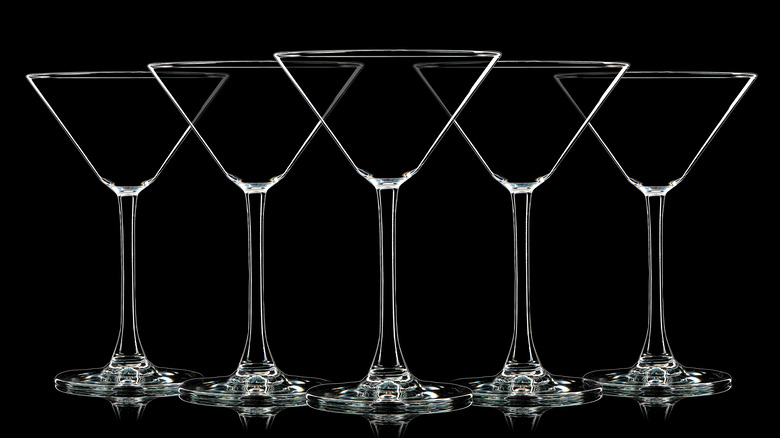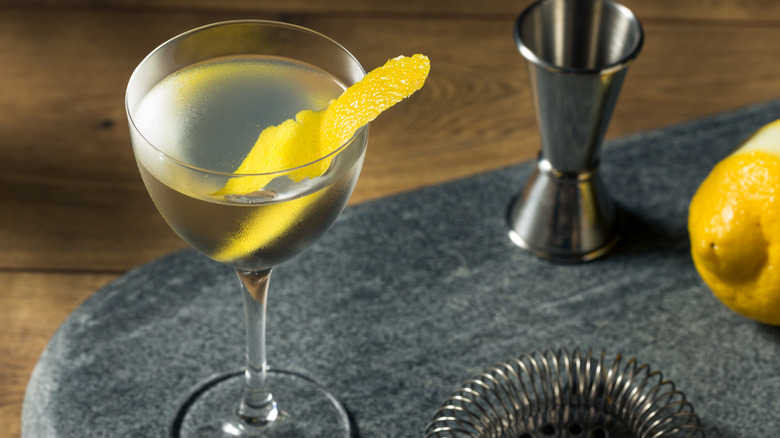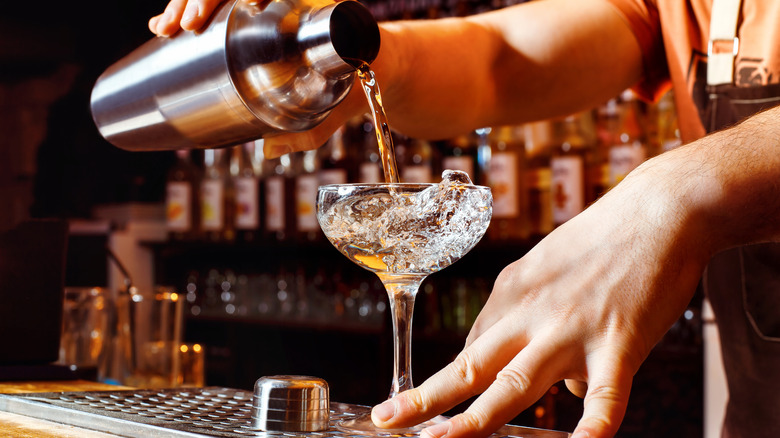13 Facts To Master For Ordering A Martini The Right Way
There's no right or wrong way to enjoy a martini. But there is a right way to order one so that you get your cocktail just the way you like it. As Sipsmith explains, understanding the basics of the classic martini, along with all of its possible variations and common terminology, will help you to successfully let a bartender know exactly how to craft your drink so you'll get a perfect martini every time.
While a martini may seem like a straightforward and simple drink, it can be deceptively complex, which is why it's important to arm yourself with as much knowledge and language as you can before you approach a bartender or server with your order. There's a martini style that will please just about everyone's palate, and you can enjoy your favorite whenever you want, exactly how you want it — as long as you know how to order it.
1. The true origin of the martini is uncertain
The history of the martini is steeped in lore and clouded by the fog of time — basically, no one really knows who invented the drink or how it got its name, according to Smithsonian Magazine. But that hasn't stopped multiple tales of its origin from spreading.
The city of Martinez, California, claims it as its own, saying the drink was invented almost by accident by a bartender during the gold rush days. Neighboring San Francisco tells an alternate story, that the martini was actually crafted by bar legend Jerry Thomas on their side of the bay. Another account alleges that the name comes from Italian vermouth makers Martini & Rossi and that either through clever marketing or ordering convenience, the martini cocktail became synonymous with their brand. Yet another narrative gives credit to a Parisian cafe owner from Syria with the surname Martini, who added his homeland's famous olives to the cocktail, as NPR reports.
We may never know the true story of how the martini came to be, but according to Difford's Guide, drinks with the name "martini" first appeared in print in the 1880s, and the cocktail as we know it today spun off from these very different recipes. The one through-line is that they all included, among various other ingredients, gin and vermouth, which are the two essential parts of the modern-day martini.
2. Gin is the traditional base spirit in a martini
It seems hard to imagine today, but not that long ago, vodka was practically an unknown entity outside of Russia. It wasn't until the 1960s and '70s that it reached mass popularity in the United States, second only to whiskey — now, it's number one, according to Wine Enthusiast. Until then, vodka martinis were not the norm. Gin was the spirit of choice.
Different styles of gin were specified in many of the pioneer martini recipes, as Difford's Guide shows. Some called for Old Tom, a richer and slightly sweeter style, or Plymouth gin, a very specific category of the spirit that comes from a single distillery in the English city of the same name (per Bon Appetit). London dry is the most common type of gin used today, known for its signature juniper flavor.
A martini can be made with any style of gin, so it's worth experimenting to find out which type or brand you enjoy the most. That way, when you're out and about, you can specify your preference. You can always ask your server or bartender to recommend a gin if you want to try something new, and you may find that you vastly prefer one style over another in your martini.
3. Vermouth is a necessary ingredient in a classic martini
The earliest martini recipes included all kinds of ingredients that you won't find in most modern martinis, including liqueurs like curacao and anisette (per Difford's Guide). Eventually, as the martini evolved closer to the one we're familiar with now, these embellishing ingredients fell away, and only two remained: gin and vermouth.
To understand the role vermouth plays in a martini, it helps to get to know it. As Cool Hunting explains, vermouth is wine that has been aromatized and fortified — basically, it's been enhanced with sugar, spirit, and botanical ingredients to give it more flavors, aromas, texture, and alcohol. Vermouths can be floral, fruity, bitter, spicy, or any combination thereof. Similar beverages have existed since ancient times, but the commercial versions we know today became popular around the 19th century.
There are three main styles of vermouth: red (also called sweet), white, and dry, as Wine Folly explains. Dry vermouth, the least sweet of the trio, is the type you'll find in a modern martini. Its addition heightens the botanical flavors and aromas of the gin while lowering the drink's alcoholic intensity, making it more pleasant to sip. If you like a sweeter cocktail, you can request white vermouth instead, or red if you want your drink sweet, dark, and spicy. And if you order a 'perfect' martini, the bartender will use a combination of both sweet and dry vermouth (per Sipsmith).
4. A classic martini is stirred, not shaken
While not typically thought of as an ingredient, per se, ice is an absolutely necessary element for crafting a martini. The way that ice is utilized when making the cocktail can have a significant effect on how the finished drink comes out, for better or for worse. While some of the earliest martini-esque progenitors called for their ingredients to be shaken, as Difford's Guide reports, once the dry martini took top billing as the prime style, stirring became the go-to technique.
One of the first rules you learn as a bartender is when to shake and when to stir a cocktail. As Bon Appetit points out, shaking is the preferred method for drinks that include non-alcoholic elements such as juice or dairy. Stirring is reserved for cocktails that consist of nothing but the hard stuff, like martinis. Shaking creates a frothy, aerated texture, while a stirred cocktail is smoother and silkier without the crunchy, icy coldness that comes from violently pulverized ice cubes.
As with every other martini variation, the preference for shaken or stirred is completely up to the drinker, who should choose the method depending on their taste. And indeed, a conscientiously shaken martini made with a gentle hand can be just as good as a well-stirred one, as Punch discovered in a blind taste test. But for the smoothest texture and most pronounced aromatics, a stirred martini is your best bet.
5. The original martini included bitters
As martini recipes developed over the years and became streamlined down to fewer and fewer ingredients, bitters held on along with the core duo of gin and vermouth for a long time. It wasn't until the '40s, according to Difford's Guide, that you began seeing martini recipes that didn't call for a few dashes of orange bitters.
If you're wondering what bitters are exactly, it's helpful to think of them as seasoning for cocktails, something you add to enhance the flavors of a recipe. Similar to vermouth, bitters are infused with botanicals to create aromas and flavors, but with distilled spirit instead of wine as a base, so they're more intense and heavily concentrated. Orange bitters are a specific category, utilizing the citrus fruit as a major component.
As Vinepair points out, adding orange bitters to a classic gin and vermouth martini isn't just theater to please cocktail nerds –- the concentrated flavors in the bitters serve to enhance the aromatics of the other ingredients, bringing bright citrus notes to the forefront. Bitters add another layer of complexity, too. This isn't always desired, as some drinkers prefer their martinis crystalline and as unadorned as possible. But the fact remains that martini enthusiasts looking to recreate a more traditional, classic cocktail should always ask for a few dashes of orange bitters when ordering their drink.
6. Lemon peel was the most common traditional martini garnish
As pointed out in Difford's Guide, both olives and lemon peels served as garnishes for martini-style cocktails from the jump. But lemon peels showed up far more often in the early days, not just as garnishes after the fact, but as ingredients to be stirred in with the liquid elements of the cocktail to infuse each drink with a brighter, more citrusy flavor.
Despite its commonplaceness, a lemon peel or twist is hardly the only option with which to garnish a martini, as Imbibe discusses. Olives are just as ubiquitous and have as long a tradition as the lemon peel. Other citrus twists, like lime and orange, add their own special aromas and flavors to the drink. And cocktail onions pretty much only exist to garnish martinis –- and once they do, the drink is transformed from a martini into a Gibson, yet another cocktail that's spurred lively debate over its true origin, according to Slate.
There's no right or wrong garnish for a martini, as each coaxes out different elements from the gin and vermouth. Once you find a gin and vermouth combination that works for you, you may as well experiment with garnishes next, to discover which one complements that style best.
7. A traditional martini is served up
A great martini is all about balance: the interplay of gin and vermouth, the subtle enhancement from the garnish. Temperature and texture can also make or break a martini. While some modern bartenders pre-make martinis and store them in the freezer until they're ready to be poured, as Punch reports, most martinis are stirred with ice before they're strained into a cocktail glass. This serving style is known as 'up' or 'straight up,' meaning the liquid is chilled but the ice is strained out of the drink (per Sipsmith).
How long the drink is stirred will dictate the final cocktail's strength and temperature. Too short a stir will result in a drink that's still got a harsh boozy bite, and may not be cold enough; too long and the drink will be watered down and thin. A good bartender knows just how many rotations it takes to achieve balance, with one to two minutes being the ideal stirring time, according to Cook's Illustrated.
The first sip of a straight-up martini might be just right, but drink too slowly and it'll warm to room temperature, eventually becoming tepid and unpleasant. While it's not traditional, ordering a martini on the rocks, meaning it's poured over ice, can solve this problem. This serving style became popular in the 1950s, as Punch describes, and seems to be making a comeback. So go ahead and order your martini on the rocks, or 'down,' if the mood strikes.
8. The term 'dry' has shifted its meaning over the years
While many original martini recipes called for sweet vermouth, over the years dry vermouth began to take over, starting at the turn of the 20th century (per Difford's Guide). The old sweeter recipes often called for a ratio of half gin, half vermouth, otherwise known as a Fifty-Fifty (a style which has its champions and detractors, as Punch reports). As the dry style of the drink grew in popularity, the proportion of vermouth lessened, but for a long time, 2:1 or 3:1 was not uncommon for a dry martini.
These days, there's no hard and fast rule when it comes to the gin and vermouth ratio in a martini, and as with all other elements of the drink, the ideal option will vary based on personal preference, as Difford's Guide explains. When ordering a martini, it helps to be specific about the amount of vermouth you like — basic terms to understand are wet and dry, with wet specifying a larger proportion of vermouth, and dry signifying less. Other terms like extra dry and bone dry similarly mean less vermouth, but their meanings can be somewhat vague.
Since these terms don't necessarily have hard numbers attached to them, they can be interpreted in different ways by different people. To be specific, you can let the bartender know what exact ratio you'd like by ordering a "three to one" or a "ten to one," and you'll always get your exact preference.
9. The dirty martini has been around since at least 1930
Olives have been used to garnish martinis since the 1880s (per Sipsmith), but it took another 50 years for drinkers to realize that olive brine could be used as an ingredient as well, and the dirty martini was born. President Franklin Roosevelt's love of the briny cocktail bolstered its notoriety, although, as Punch notes, it didn't reach its peak of popularity until the '90s, when it was most commonly made with vodka.
Now, the dirty martini has captured the imagination of countless bartenders looking to rehabilitate the drink's image using modern craft cocktail techniques and sensibilities. Innovative mixologists around the world are employing unusual, inspired methods to add just the right touch of savory, salty olive flavor to the martini, including creating custom olive-infused bitters and spirits. And rather than relying on the same old liquid packaged with commercially produced olives, more quality-minded bartenders are turning to specialty brines made expressly for premium cocktails.
Dirty martinis come in different iterations too, so when ordering one, don't forget vermouth is still a factor unless you ask for it to be omitted. You can use the same ratio system as with vermouth to specify how much olive brine you want compared to your gin (or vodka), or you can use the terms dirty, extra dirty, or filthy to give the bartender a basic idea of how briny you want it.
10. The vodka martini is a more recent creation
It wasn't until 1951 that the now-famous (or infamous, depending on who you ask) vodka martini appeared in print, and five years later, Ian Fleming helped the drink skyrocket into pop culture immortality by having his fictional creation, James Bond, order the drink in one of his novels, as Decanter recounts.
Replacing complex, flavorful gin with the more neutral spirit in a martini might seem like sacrilege to some, but the drink's popularity can't be denied. While once purists and cocktail experts may have turned their noses up at vodka martinis, that's changed in recent years. As Punch explains, with more high-quality vodkas entering the market, vodka cocktails can be just as interesting and flavorful as those made with spirits like gin. And in fact, many mixologists prefer vodka for dirty martinis, as its less pronounced flavor melds better with the salty, savory brine.
Whether you prefer a stirred vodka martini for its smoothness, or enjoy emulating James Bond at the bar by ordering it shaken, there's no need to hesitate — the days of judging vodka martini drinkers are long gone.
11. The martini cocktail predates its iconic glass
The martini had been around for ages before it became synonymous with the Y-shaped glass that's now commonly used as its vessel, according to Imbibe. Before the long stem and triangle bowl appeared on the scene in the 1920s, martinis were served in coupes, tumblers, and even wine glasses (per Wine Enthusiast). The precise, modern silhouette of the angular martini glass fit in perfectly with the art deco style popular at that time, and martini drinkers have continued to embrace the style for a century.
Not everyone is a fan of the martini glass, as Imbibe discusses, pointing out a few issues that hamper its practicality. When full, the weight is concentrated at the top, causing imbalance, and the wide mouth makes the glass difficult to move without spilling. It's a challenge to drink from, as well as to carry. But even with these shortcomings, after a hundred years, it's hard to imagine that the iconic glass will ever truly fall out of style.
12. James Bond's drink of choice was originally the Vesper
The cinematic James Bond kicked off his cocktail habit with a dry vodka martini in the 1962 film "Dr. No" and coined the memorable phrase 'shaken, not stirred' a few movies later (per 007.com). But the literary version of the world's most famous super spy started off with a different drink, one that had never been created before. Bond (by way of author Ian Fleming) eventually called this cocktail the Vesper, after his love interest with the same name in "Casino Royale," as Berry Bros & Rudd explains.
Like a classic martini, the Vesper is a combination of spirit and aromatized wine. What sets it apart is that the spirit base is split between vodka and gin, and the aromatized wine called for is a specific type, known as Kina Lillet. Sadly, that specific item is no longer produced, but many people use its modern and less bitter descendant, Lillet Blanc, in its place, according to Difford's Guide.
Whether Bond was drinking vodka martinis or Vespers, he always preferred his drinks shaken. However you feel about shaking versus stirring, if you want to experience this drink as close to Fleming's original creation as possible, shaking is the way to go, as Difford's Guide recommends.
13. The martini is constantly evolving
Today's martini is nearly unrecognizable from where the cocktail began, as Punch lays out. We have no idea what the typical martini will look like in the future, and as Edible San Francisco discusses, modern iterations are already pushing the boundaries of what a martini can be. With that in mind, martini enthusiasts should feel confident ordering the cocktail in whatever shape or form that suits their palate, without being beholden to past traditions. Wet or dry, gin or vodka, shaken or stirred, up or on the rocks — the variations for this drink are nearly endless, meaning there is a style of martini to bring just about everyone satisfaction and enjoyment, no matter what their palate prefers.
Whether you're a martini novice or a cocktail buff, knowing the basics about this drink will certainly enhance the martini drinking experience, however you choose to quaff the classic concoction.
